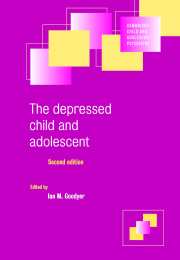Book contents
- Frontmatter
- Contents
- List of contributors
- Preface
- 1 Historical aspects of mood and its disorders in young people
- 2 The development of emotional intelligence
- 3 Developmental precursors of depression: the child and the social environment
- 4 Physiological processes and the development of childhood and adolescent depression
- 5 Childhood depression: clinical phenomenology and classification
- 6 The epidemiology of depression in children and adolescents
- 7 Family–genetic aspects of juvenile affective disorders
- 8 Life events: their nature and effects
- 9 Adolescent depression: neuroendocrine aspects
- 10 Suicidal behaviour in adolescents
- 11 Psychopharmacology of depressive states in childhood and adolescence
- 12 The psychotherapeutic management of major depressive and dysthymic disorders in childhood and adolescence: issues and prospects
- 13 Natural history of mood disorders in children and adolescents
- Index
4 - Physiological processes and the development of childhood and adolescent depression
Published online by Cambridge University Press: 18 December 2009
- Frontmatter
- Contents
- List of contributors
- Preface
- 1 Historical aspects of mood and its disorders in young people
- 2 The development of emotional intelligence
- 3 Developmental precursors of depression: the child and the social environment
- 4 Physiological processes and the development of childhood and adolescent depression
- 5 Childhood depression: clinical phenomenology and classification
- 6 The epidemiology of depression in children and adolescents
- 7 Family–genetic aspects of juvenile affective disorders
- 8 Life events: their nature and effects
- 9 Adolescent depression: neuroendocrine aspects
- 10 Suicidal behaviour in adolescents
- 11 Psychopharmacology of depressive states in childhood and adolescence
- 12 The psychotherapeutic management of major depressive and dysthymic disorders in childhood and adolescence: issues and prospects
- 13 Natural history of mood disorders in children and adolescents
- Index
Summary
Recent conceptualizations of developmental psychopathology provide a useful framework for studying depression in childhood and adolescence (Sroufe & Rutter, 1984; Cicchetti & Schneider-Rosen, 1986; Rutter, 1986). These conceptualizations offer a framework for how depressed mood and clinical depression develop within sociocultural, biogenetic, personality and family domains, and how both types of depression change over time as a function of these domains. A developmental perspective focuses on the continuities and discontinuities between normal growth and psychopathology, age-related and gender-related alterations in coping and in symptom expression, and behavioural reorganizations that occur around salient developmental transitions. These include internal and external sources of competence and vulnerability, and the effects of development on pathology and of pathology on development (Attie & Brooks-Gunn, 1992). More work using such a framework has been conducted on depression than on other forms of psychopathology (Cicchetti & Schneider-Rosen, 1986; Rutter et al., 1986; Goodyer, 1990; Brooks-Gunn & Petersen, 1991; Cicchetti & Toth, 1991; Cicchetti et al., 1992).
In this chapter, we examine five issues of childhood and adolescent depression that consider the interplay between continuity and risk. The first focuses on the rate of various forms of depression in the childhood and adolescence years, to see whether, and at what ages, discontinuities in the prevalence of depression exist. Since children and adolescents differ in their rates of depressed mood and clinical depression, we go on to ask about the factors that might account for these discontinuities. The second issue, then, tracks the physiological concomitants and possible predictors of depression among the physiological changes that characterize early adolescence.
Keywords
- Type
- Chapter
- Information
- The Depressed Child and Adolescent , pp. 79 - 118Publisher: Cambridge University PressPrint publication year: 2001
- 5
- Cited by



